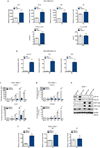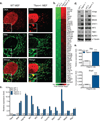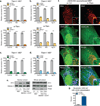Mitochondrial DNA stress primes the antiviral innate immune response
- PMID: 25642965
- PMCID: PMC4409480
- DOI: 10.1038/nature14156
Mitochondrial DNA stress primes the antiviral innate immune response
Abstract
Mitochondrial DNA (mtDNA) is normally present at thousands of copies per cell and is packaged into several hundred higher-order structures termed nucleoids. The abundant mtDNA-binding protein TFAM (transcription factor A, mitochondrial) regulates nucleoid architecture, abundance and segregation. Complete mtDNA depletion profoundly impairs oxidative phosphorylation, triggering calcium-dependent stress signalling and adaptive metabolic responses. However, the cellular responses to mtDNA instability, a physiologically relevant stress observed in many human diseases and ageing, remain poorly defined. Here we show that moderate mtDNA stress elicited by TFAM deficiency engages cytosolic antiviral signalling to enhance the expression of a subset of interferon-stimulated genes. Mechanistically, we find that aberrant mtDNA packaging promotes escape of mtDNA into the cytosol, where it engages the DNA sensor cGAS (also known as MB21D1) and promotes STING (also known as TMEM173)-IRF3-dependent signalling to elevate interferon-stimulated gene expression, potentiate type I interferon responses and confer broad viral resistance. Furthermore, we demonstrate that herpesviruses induce mtDNA stress, which enhances antiviral signalling and type I interferon responses during infection. Our results further demonstrate that mitochondria are central participants in innate immunity, identify mtDNA stress as a cell-intrinsic trigger of antiviral signalling and suggest that cellular monitoring of mtDNA homeostasis cooperates with canonical virus sensing mechanisms to fully engage antiviral innate immunity.
Figures












Comment in
-
Innate immunity: Stressed mitochondria provide protection.Nat Rev Immunol. 2015 Mar;15(3):134. doi: 10.1038/nri3828. Epub 2015 Feb 20. Nat Rev Immunol. 2015. PMID: 25698673 No abstract available.
-
Stressed mitochondria sound the alarm.Immunol Cell Biol. 2015 May-Jun;93(5):427-8. doi: 10.1038/icb.2015.31. Epub 2015 Mar 10. Immunol Cell Biol. 2015. PMID: 25753269 No abstract available.
-
Innate immune recognition of mtDNA--an undercover signal?Cell Metab. 2015 Jun 2;21(6):793-4. doi: 10.1016/j.cmet.2015.05.019. Cell Metab. 2015. PMID: 26039443
References
-
- Spelbrink JN. Functional organization of mammalian mitochondrial DNA in nucleoids: history, recent developments, and future challenges. IUBMB Life. 2010;62:19–32. - PubMed
-
- Kasashima K, Sumitani M, Endo H. Human mitochondrial transcription factor A is required for the segregation of mitochondrial DNA in cultured cells. Exp Cell Res. 2011;317:210–220. - PubMed
-
- Ryan MT, Hoogenraad NJ. Mitochondrial-nuclear communications. Annu Rev Biochem. 2007;76:701–722. - PubMed
-
- Larsson NG, et al. Mitochondrial transcription factor A is necessary for mtDNA maintenance and embryogenesis in mice. Nat Genet. 1998;18:231–236. - PubMed
Methods Section References
-
- Stetson DB, Medzhitov R. Recognition of cytosolic DNA activates an IRF3-dependent innate immune response. Immunity. 2006;24:93–103. - PubMed
-
- Dalton KP, Rose JK. Vesicular stomatitis virus glycoprotein containing the entire green fluorescent protein on its cytoplasmic domain is incorporated efficiently into virus particles. Virology. 2001;279:414–421. - PubMed
Publication types
MeSH terms
Substances
Associated data
- Actions
Grants and funding
LinkOut - more resources
Full Text Sources
Other Literature Sources
Molecular Biology Databases
Research Materials

